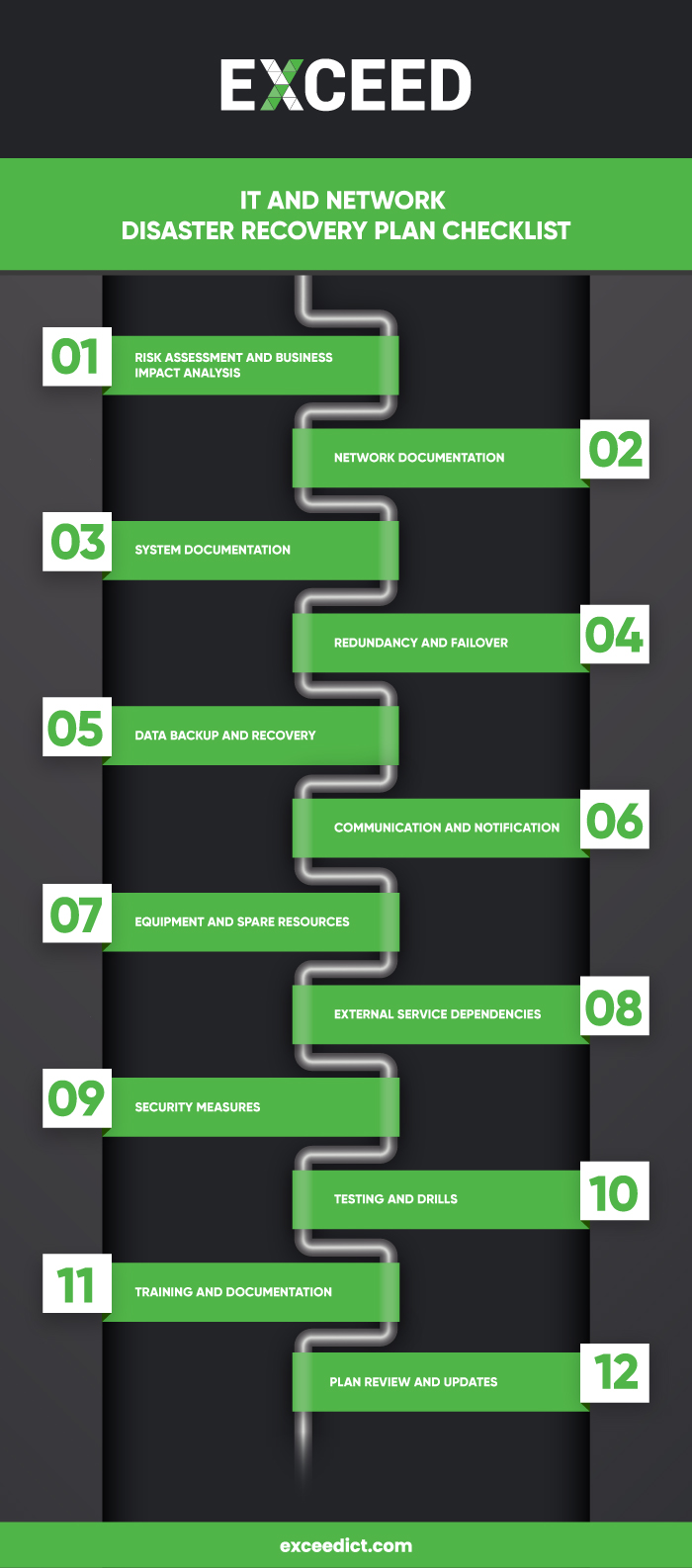
IT and Network Disaster Recovery Plan Checklist

The Network Disaster Recovery Plan Checklist is a concise set of instructions developed to aid in managing and recovering from network disasters. It offers a structured approach to address pre-disaster preparations, response strategies during disruptions, and post-disaster recovery actions.
And
The IT Network Disaster Recovery Plan Checklist is a structured set of guidelines designed to help organisations in the United Kingdom prepare for and respond effectively to network-related disasters.
It outlines essential steps and actions to take before, during, and after a network disruption, aiming to minimise downtime, data loss, and operational impact.
This checklist assists in ensuring the organisation’s IT infrastructure and connectivity can be restored swiftly, safeguarding business continuity and data integrity.
Network Disaster Recovery Plan Checklist
-

Network Disaster Recovery Plan Checklist Risk Assessment and Business Impact Analysis:
-
- Identify potential network-related disasters and threats.
- Evaluate the potential impact of each scenario on business operations and network availability.
- Prioritise critical network components and services.
-
Network Documentation:
-
- Document your network topology, including hardware, software, configurations, and interconnections.
- Maintain up-to-date diagrams and documentation for easy reference during recovery.
-
Redundancy and Failover:
-
- Implement redundancy for critical network components (e.g., routers, switches, firewalls).
- Set up failover mechanisms to ensure seamless network operation during a disaster.
-
Data Backup and Recovery:
-
- Regularly backup network configurations, settings, and device images.
- Store backups securely off-site or in the cloud.
- Test restoration procedures periodically to ensure data integrity.
-
Communication and Notification:
-
- Establish a communication plan for informing IT staff, stakeholders, and users about network disruptions and recovery progress.
- Define roles and responsibilities for communication tasks.
-
Equipment and Spare Resources:
-
- Maintain an inventory of spare network equipment (routers, switches, etc.) for quick replacement.
- Ensure spare equipment is properly configured and ready for use.
-
External Service Dependencies:
-
- Identify external services (e.g., internet service providers, cloud services) critical for network operation.
- Understand their disaster recovery plans and ensure communication channels are established.
-
Security Measures:
-
- Implement security protocols to protect the network during and after a disaster.
- Regularly update firewalls, intrusion detection/prevention systems, and access controls.
-
Testing and Drills:
-
- Conduct network recovery drills to test failover mechanisms and restoration processes.
- Analyze test results to identify areas for improvement.
-
Training and Documentation:
-
- Provide training to IT staff on network recovery procedures.
- Keep network recovery documentation accessible and up to date.
-
Plan Review and Updates:
-
- Regularly review and update the network disaster recovery plan to account for changes in technology, infrastructure, and potential risks.
IT Disaster Recovery Plan Checklist
-
Risk Assessment and Business Impact Analysis:
-
- Identify potential IT-related disasters and threats.
- Assess the potential impact of each scenario on business operations and IT systems.
- Prioritize critical IT assets, applications, and data.
-
Data Backup and Recovery:
-
- Regularly back up critical data, applications, and configurations.
- Store backups securely off-site or in the cloud.
- Test data restoration procedures periodically to ensure data integrity.
-
System Documentation:
-
- Document IT systems, hardware, software, configurations, and network topology.
- Maintain up-to-date documentation for easy reference during recovery.
-
Redundancy and Failover:
-
- Implement redundancy for critical IT components (e.g., servers, storage, databases).
- Set up failover mechanisms to ensure continuous IT service availability.
-
Communication and Notification:
-
- Establish a communication plan for informing IT staff, stakeholders, and users about IT disruptions and recovery progress.
- Define roles and responsibilities for communication tasks.
-
IT Infrastructure and Hardware:
-
- Inventory and maintain spare hardware components (e.g., servers, switches) for rapid replacement.
- Ensure spare hardware is configured and ready for use.
-
Application and Software Recovery:
-
- Document procedures for reinstalling and configuring critical applications.
- Maintain up-to-date software installation media and licenses.
-
Security Measures:
-
- Implement security protocols to protect IT systems during and after a disaster.
- Regularly update antivirus, firewalls, and intrusion detection/prevention systems.
-
Testing and Drills:
-
- Conduct IT recovery drills to test system failover, restoration processes, and data integrity.
- Analyze test results to identify areas for improvement.
- Training and Documentation:
-
- Provide IT staff with training on recovery procedures.
- Keep IT recovery documentation accessible and up to date.
-
Plan Review and Updates:
-
- Regularly review and update the IT disaster recovery plan to accommodate changes in technology, infrastructure, and potential risks.
You may also like to know more about
- IT Disaster Recovery Planning Process for Ensuring Business Continuity.
- Disaster Recovery Plan For Ensuring Business Continuity in Challenging Times.
- Business Continuity Planning vs Disaster Recovery Planning.
- Step by Step Guide for a business continuity plan.
- What is Business Continuity Planning? Importance, Risk Assessment, & Core Objectives.
- Understanding the Disaster Recovery Planning – steps, benefits and best practices.
- Disaster Recovery Planning To Ensure The Connectivity in Crisis.
Stay connected with EXCEED ICT
Stay connected with EXCEED ICT by joining our social networks (given at footer). Get the latest updates, news, and tips for enterprise device deployment. Follow us on Twitter, Facebook, and LinkedIn for the best enterprise device deployment solutions.
Help us to improve our enterprise by rating us on Google Maps. Your feedback and comments are valuable to us and will be used to make our services even better.



